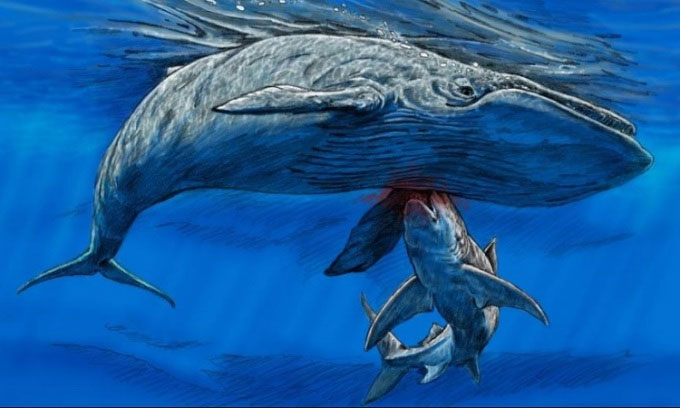Fossilized Flipper Reveals a Large Shark That Fed on a Whale Carcass Floating in the Sea 15 Million Years Ago.
A species of voracious shark, possibly the megalodon (Otodus megalodon), the largest shark to ever roam the Earth, fed on a baleen whale approximately 15 million years ago in waters that are now part of Maryland, according to new research on the flipper bones of the whale. However, analysis of bite marks on the flipper suggests that the whale may have already been dead and floating on the surface. Thus, the massive shark likely consumed the decaying carcass, biting into the flipper and tearing off chunks of flesh from the whale’s head.

Reconstruction of a shark feeding on an ancient whale carcass on the water. (Photo: Tim Scheirer and Clarence (Shoe) Schumaker)
“The bite marks and flesh-tearing evidence, including shallow, arc-shaped punctures on the flipper, are indicative of scavenging behavior rather than active predation,” said Stephen Godfrey, the lead researcher and curator of paleontology at the Calvert Marine Museum in Solomons, Maryland.
Fossil collector William (Douggie) Douglass from Maryland discovered the whale bones, dating back to the Miocene epoch (5.3 to 23 million years ago), on a beach near the naturally eroded Calvert Cliffs, a region famous for its marine fossil finds. During the Miocene, the Atlantic Ocean covered what is now Maryland’s Chesapeake Bay. Sediments filled with fossils formed the cliffs that were submerged underwater 9 to 20 million years ago.
Douglass donated the whale bone fossil to the Calvert Marine Museum. The 27.5 cm long flipper bone is relatively flat and has a slight curve, indicating it belonged to a baleen whale. Godfrey and intern Annie Lowry discovered bite marks on both sides of the flipper.
“The shark must have clamped down on the flipper very tightly and then pulled hard to break the bone or tear the flesh. After getting some meat, it would bite the flipper again for more,” Godfrey speculated. “When the whale died, its body would have turned upside down and floated on the surface due to gas buildup in the abdomen from decomposition. Scavenging sharks often feed at the surface, sometimes even breaching, making the whale’s flipper an easy target for the large shark.”
The shark that fed on the whale carcass could belong to several species: Alopias grandis, Alopias palatasi, Carcharhinus, Carcharodon hastalis, Galeocerdo aduncus, Hemipristis serra, juvenile O. megalodon, Physogaleus contortus, and Sphyrna laevissima. The bite marks do not reveal whether the shark had serrated teeth. If the marks were not made by serrated teeth, the likely culprit is Carcharodon hastalis, an ancestor of today’s great white shark.
The research team announced their findings on October 24 in the journal Carnets Geology and will present online on November 5 at the annual meeting of the Society of Vertebrate Paleontology.


















































